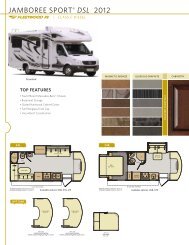You also want an ePaper? Increase the reach of your titles
YUMPU automatically turns print PDFs into web optimized ePapers that Google loves.
Storage<br />
19 . Pour one cup of antifreeze solution down<br />
each drain .<br />
20 . Install all protective caps:<br />
Water tank fill<br />
City water inlet cap<br />
Waste tank drain outlet cap<br />
21 . If your refrigerator is equipped with an ice<br />
maker, winterize it as follows:<br />
12-4<br />
1 . Shut off the water supply valve to the ice<br />
maker .<br />
2 . Place a shallow pan under the water<br />
solenoid valve .<br />
3. Remove the inlet fitting to the ice maker<br />
water solenoid valve . Drain the water<br />
from the supply line .<br />
4 . Remove the plastic nut and water line<br />
from the outlet side of the water solenoid<br />
valve . Drain water from the line .<br />
5 . Cycle the ice maker several times while<br />
blowing compressed air through the<br />
water solenoid valve . Be sure all water is<br />
out of the solenoid . NOTE: Your motor<br />
home dealer can do this for you.<br />
6 . Reconnect and tighten the lines on the<br />
solenoid valve . Leave the water supply<br />
turned off until temperatures are above<br />
32°F/0°C .<br />
7 . Dry out the ice maker mold assembly<br />
with a soft cloth . Place the bail arm to<br />
the UP/OFF position .<br />
REACTIVATING THE MOTOR<br />
HOME AFTER STORAGE<br />
If the motor home was properly and carefully<br />
prepared for storage, taking it out of storage<br />
will not be difficult. The following procedure<br />
check list assumes that you stored the motor<br />
home with care . If you didn’t, and extensive<br />
freeze damage or other serious deterioration has<br />
occurred, please consult your dealer or an authorized<br />
<strong>Fleetwood</strong> Dealer for advice .<br />
1 . Thoroughly inspect the outside of the vehicle<br />
. Look for animal nests in wheel wells,<br />
under the hood, in air cleaner or in other<br />
out of the way places .<br />
2 . Remove all appliance vents, ceiling vent<br />
and air conditioner coverings . Be sure<br />
all furnace, water heater, and refrigerator<br />
openings are clear and free of debris or<br />
insect nests, webs, etc .<br />
3 . Open all doors and compartments . Check<br />
for animal or insect intrusion, water damage,<br />
or other deterioration .<br />
4. Check all chassis fluid levels — engine oil,<br />
engine coolant, power steering fluid, brake<br />
fluid, transmission fluid, rear axle oil.<br />
5. Check charge level in batteries. Refill and<br />
recharge as necessary . Reinstall batteries<br />
if necessary . Be sure cable ends and<br />
terminals are clean and free of corrosion .<br />
Check Chassis Operator’s/Owner’s Guide/<br />
Manual for any instructions on resetting<br />
chassis computer after battery is reinstalled .<br />
6. Check tire pressures. Inflate to specified<br />
cold pressure .<br />
7 . Remove covering from inside windows .<br />
8 . Open vents and windows for ventilation .<br />
9 . Be sure engine instruments indicate proper<br />
readings . Run engine up to operating temperature.<br />
Shut engine down. Check all fluids<br />
. Top up if necessary .<br />
10 . During engine run, check the operation of<br />
headlights, tail-lights, turn signals, backup<br />
lights, clearance lights, license plate light,<br />
emergency flashers. Operate the vehicle<br />
air conditioner . If air conditioner does not<br />
work, or unusual sounds occur, have the<br />
system checked by a qualified air conditioner<br />
technician .<br />
11. Drain, flush, and sanitize the fresh water<br />
system as outlined in the Plumbing chapter .<br />
12. Install a new water filter cartridge<br />
(if equipped) .






